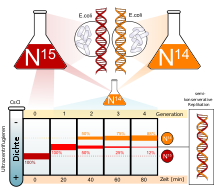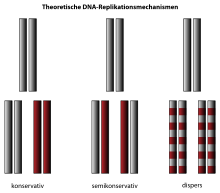Meselson–Stahl experiment
The biologists Matthew Meselson and Franklin Stahl developed the Meselson-Stahl experiment, published in 1958 and named after them, with which it can be demonstrated that the replication of DNA is semiconservative (half-preserving), i.e. half of the genetic material of the daughter cells after cell division consists of the genetic information of the mother cell and half is newly synthesised.
In addition to semiconservative replication, the hypotheses of conservative and dispersive replication have been discussed previously:
- In conservative replication, the mother DNA is completely retained and the copies of its two single strands assemble into a new double strand.
- In semiconservative replication, half of the mother DNA is retained in each daughter molecule. The other half is replenished.
- In principle, disperse replication (also known as dispersive replication) proceeds in a similar way. Here, too, half of the mother DNA is retained in each daughter DNA, while the other half is replaced by new nucleotides. However, the replacement mechanism is completely different - because the nucleotides of the mother DNA alternate with the newly added nucleotides.
For their experiment, the researchers first grew bacteria on a nutrient medium that contained only a nitrogen isotope with a mass number of 15. This was then integrated by the bacteria into their DNA. Bacteria from this strain were then placed on a nutrient medium containing nitrogen with a mass number of 14. After 20 minutes, bacteria of the first successor generation (F1 generation) were then removed and their genetic material subjected to density gradient centrifugation. It was found that the sedimentation level of bacterial DNA was exactly between the reference levels of DNA containing only 14 and 15 u nitrogen, respectively. This ruled out the hypothesis of conservative replication, since otherwise two sedimentation planes would have had to form at the level of the reference planes.
In order to decide which of the two remaining hypotheses was correct, the process was repeated with individuals of the F2 generation. This revealed that half of the bacteria's genetic material sedimented in the plane of the F1 generation and half in the 14 u reference plane. This is exactly in line with the predictions of the semiconservative hypothesis, but does not completely rule out dispersed replication. Theoretically, fragments could be conserved in dispersed replication and always alternate new and old DNA fragments (due to some mechanism), which would cause the density of DNA to behave exactly as in the experiment. To completely eliminate dispersed replication, Meselson and Stahl heated the F1-generation DNA in the density gradient centrifuge medium to 100 °C for 30 min, which split the double-stranded DNA into single strands (Meselson and Stahl observed that the weight of the molecules was approximately halved). Density gradient centrifugation now revealed two bands that corresponded to the bands of heated pure N15 and N14 DNA, respectively. This allowed the exclusion of dispersed replication.

Density gradient according to different generations

The three theoretically possible mechanisms of replication
See also
- Taylor experiment (genetics)
Questions and Answers
Q: What is the Meselson-Stahl experiment?
A: The Meselson-Stahl experiment was an experiment conducted by Matthew Meselson and Franklin Stahl in 1958, using E. coli DNA to determine that DNA replication is semi-conservative.
Q: How does semi-conservative replication work?
A: In semi-conservative replication, half of the original DNA is kept while the other half is synthesized into new strands.
Q: What are the three possible ways that DNA could replicate?
A: The three possible ways that DNA could replicate are conservative replication, semi-conservative replication, and disperse replication.
Q: How did Meselson and Stahl prove that semi-conservative replication was correct?
A: To prove that semi-conservative replication was correct, they put bacteria in an environment with a Nitrogen isotope (N15) which integrated into their DNA. They then used an environment containing N14 and observed which isotopes were present in the bacterial DNA - both N15 and N14 were found, ruling out conservative and disperse replications as possibilities.
Q: What did they observe when looking at helix strands from the time in the N15 environment?
A: When looking at helix strands from the time in the N15 environment, they found some with only v while others had both N14 and N15 present.
Search within the encyclopedia